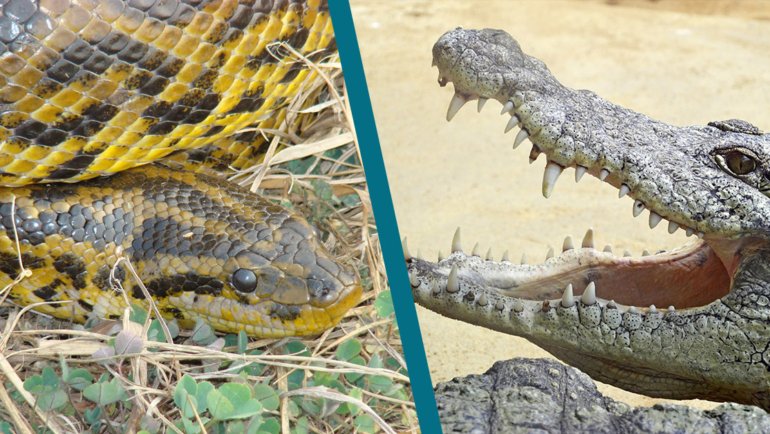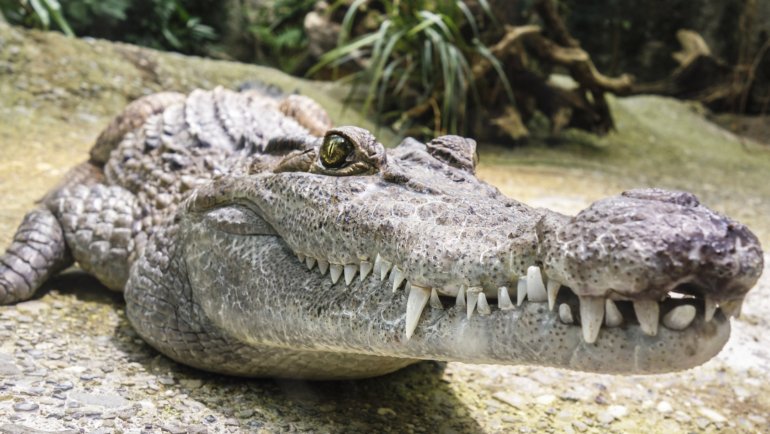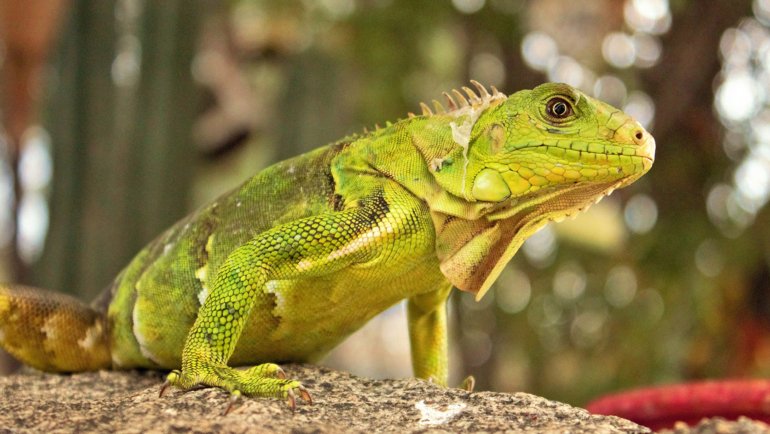Anacondas, often evoking a blend of fascination and fear, are among the world’s largest and most talked-about snakes. These serpentine giants, predominantly found in South America’s dense rainforests and sprawling wetlands, have been the subject of countless tales, movies, and myths.
Their sheer size and elusive nature contribute to their mystique, making them an enduring subject of intrigue. Among the many questions posed about anacondas, one that frequently surfaces is related to their reproduction: do anacondas lay eggs?
Reproduction in snakes is a fascinating subject, with different species employing various methods to bring forth their young. While many might assume, given the prevalence of oviparous (egg-laying) reptiles, that anacondas lay eggs, this is a common misconception. Let’s delve into the specifics and uncover the truth behind how these majestic creatures reproduce.
Oviparous vs. Ovoviviparous: A Quick Overview
Before diving into the reproductive methods of anacondas, it’s crucial to understand the difference between two primary reproductive strategies found in reptiles: oviparity and ovoviviparity.
Oviparous: This term refers to animals that lay eggs. In oviparous species, fertilization can occur either inside or outside the body. Once the eggs are laid, embryonic development continues outside the mother’s body, within the egg. Most snakes, birds, and many reptiles are oviparous. For example, pythons and sea turtles lay eggs that later hatch outside the mother’s body.
Ovoviviparous: Ovoviviparity is a mode of reproduction where embryos develop inside eggs but remain within the mother’s body until they are ready to hatch. The mother then gives birth to live young.
Unlike viviparous animals (where the fetus is directly nourished by the mother, like in mammals), the developing embryos in ovoviviparous animals receive nutrients from the yolk sac of the egg and not directly from the mother. Examples include some species of sharks, certain lizards, and, pertinently, the anaconda.
Anaconda Reproduction: A Deep Dive
When discussing the breeding habits and reproductive strategies of anacondas, several distinctive features set them apart from other snakes.
The Anaconda’s Breeding Ball
Anacondas have a unique mating ritual that is both fascinating and peculiar. When a female anaconda is ready to mate, she releases a pheromone trail to attract potential suitors. This results in multiple males converging on her location, and what ensues is a tangled mass of writhing snake bodies known as a “breeding ball.”
This ball can sometimes last for several weeks, with males competing for the chance to mate with the female. The strongest or most persistent male usually emerges as the victor, ensuring the transfer of the most resilient genes to the next generation.
The Ovoviviparous Nature of Anacondas
Unlike many other snakes that lay eggs, anacondas give birth to live young. After the act of mating, the fertilized eggs remain inside the female’s body. These eggs, encapsulated in a thin membrane, start developing within the mother.
As the embryos grow, they feed off the yolk inside their respective eggs. When they are ready to be born, the eggs hatch inside the mother, and she then gives birth to live snakelets. This method of reproduction is termed as ovoviviparity.
Internal Fertilization and Embryo Development
Anacondas employ internal fertilization, which means that the sperm from the male snake fertilizes the eggs inside the female’s body. Following fertilization, the developing embryos remain within the female and derive their nourishment primarily from the yolk sac of the egg.
The mother’s body provides protection and the appropriate temperature for the developing embryos. After a gestation period, the young anacondas, fully developed, emerge alive from the mother, ready to face the challenges of their environment.
Benefits of Being Ovoviviparous for Anacondas
The reproductive method adopted by a species often reflects the demands and threats of its natural habitat. For anacondas, being ovoviviparous has its set of advantages:
- Protection from Predators: By retaining the developing embryos inside her body, the mother anaconda ensures they are protected from potential external threats. Eggs, left alone in the wild, can fall prey to various predators. But in the case of anacondas, the young have the safety of their mother’s body until they are relatively more developed and capable of evading threats.
- Thermoregulation: Anacondas reside in regions where temperature fluctuations can be common. By being ovoviviparous, they can control the internal temperature of the developing embryos, ensuring a stable environment. This is in contrast to oviparous snakes that need to find an ideal location with a consistent temperature to lay and incubate their eggs.
- Higher Survival Rates: Live births generally translate to a higher survival rate for the young. Once hatched inside, the young snakes are already at a developmental stage where they can swim, explore, and even hunt. This immediate readiness boosts their chances of survival compared to newly hatched snakes from eggs.
In summary, the reproductive strategy of anacondas, specifically their ovoviviparous nature, reflects a combination of evolutionary adaptation and environmental necessity. This method not only increases the chances of survival for their young but also underscores the intricate ways in which species evolve to best fit their surroundings.
The Birth Process of Anacondas
Anacondas, being among the giants of the snake world, have an intriguing birth process that is a marvel of nature. Understanding this process provides a window into their lifecycle and the intricacies of their survival strategy.
Gestation Period: After mating, the female anaconda goes through a gestation period, which is the time taken for the young snakes to develop internally. For anacondas, this period typically ranges from six to seven months, depending on various environmental factors and the specific health of the snake.
During this time, the female needs to ensure she remains in optimal conditions to support the developing embryos. This often means choosing suitable locations with appropriate temperature and humidity levels and avoiding potential threats.
Baby Anacondas’ Birth: When it’s time to give birth, the female anaconda finds a safe, secluded spot in the water. As she starts the birthing process, young snakelets, encased in a thin, transparent membrane, emerge.
This membrane is usually shed quickly, and the young anacondas are immediately active. A single female can give birth to 20 to 40 young ones in a single litter, although numbers can vary based on the age and health of the female.
Immediate Activities Post-Birth: The newborn anacondas are replicas of the adults in miniature form, measuring between 60 to 80 centimeters (about 24 to 31 inches) in length. From the moment they are born, these baby anacondas are independent and receive no parental care.
They swiftly take to their watery environment, swimming and hunting for small prey like frogs and fish. Their early days are crucial, as they need to avoid a myriad of predators while growing rapidly.
How Do Other Snakes Reproduce?
Snakes, with their vast diversity, have a range of reproductive methods. These strategies often reflect the specific demands of their habitats and lifestyles.
- Oviparous Snakes: A significant number of snake species are oviparous, meaning they lay eggs. These eggs are often laid in hidden, secure spots like burrows, under rocks, or in leaf litter. Examples include pythons, rat snakes, and cobras. The female sometimes guards the eggs until they hatch, while others leave the eggs to their fate.
- Viviparous Snakes: Some snakes give birth to live young without the involvement of eggs at any stage. These snakes have a direct placental connection with their young, similar to mammals. Examples of viviparous snakes include the boa constrictor and many species of vipers.
- Ovoviviparous Snakes: Apart from anacondas, several other snake species are ovoviviparous. These snakes include the rattlesnakes and the garter snake. As previously described, these snakes retain eggs internally, which hatch within the mother, and she then gives birth to live young.
Each reproductive strategy, be it oviparous, viviparous, or ovoviviparous, offers unique advantages based on the snake’s environment and lifestyle. While egg-laying can allow for higher numbers of offspring and dispersion in favorable conditions, live births can ensure higher survival rates in more challenging environments.
Debunking Myths About Anacondas’ Reproduction
With any animal as captivating and mysterious as the anaconda, myths and misconceptions are bound to arise. When it comes to their reproduction, several myths persist, which can mislead or confuse those unfamiliar with the true nature of these serpents. Here’s a closer look at some of these myths and the factual information to debunk them.
- “Anacondas lay massive eggs”: As we’ve already established, anacondas do not lay eggs. They are ovoviviparous, meaning they give birth to live young. This misconception often arises due to the sheer size of the anaconda, leading people to assume that such a large snake must lay correspondingly large eggs.
- “Baby anacondas are venomous from birth”: Anacondas, irrespective of their age, are not venomous. They are constrictors that use their immense strength to suffocate their prey, rather than venom.
- “Anacondas mate for life”: While the “breeding ball” mating ritual of anacondas is indeed fascinating, there’s no evidence to suggest they form lifelong bonds. Males will compete for a receptive female, but after mating, they go their separate ways.
Frequently Asked Questions
How many babies does an anaconda give birth to at once?
Anacondas can give birth to a large number of babies in a single birthing event. A single female can birth anywhere from 20 to 40 baby anacondas, but this number can vary.
Do mother anacondas take care of their young?
No, baby anacondas are independent from the moment they are born. They do not receive parental care and immediately start fending for themselves.
How soon can baby anacondas hunt after birth?
Almost immediately. The young are capable swimmers and hunters, going after small prey like frogs and tiny fish shortly after birth.
Are there any snakes that neither lay eggs nor give birth to live young?
No, snakes either lay eggs (oviparous) or give birth to live young, which can be via direct viviparity or through retained eggs that hatch internally (ovoviviparous).
How do anacondas attract mates?
Female anacondas emit a scent trail when they’re ready to mate. Males pick up on this scent and will follow it to find the female. Multiple males can pursue a single female, leading to the formation of the “breeding ball” where several males coil around a single female, competing to mate with her.
Learn More About Anacondas
- Anaconda: Characteristics, Diet, Facts & More [Fact Sheet]
- Do Anacondas Eat People? Has It Happened Before?
- Anaconda vs. Crocodile: How Do They Compare and Who Wins in a Fight?
- Where Do Anacondas Live? Range and Preferred Habitats
- King Cobra vs. Anaconda: A Comparative Look at Two Giant Snakes
- What Do Anacondas Eat? The Diet of The Amazon’s Giant
- Anaconda Teeth: Do Anacondas Have Fangs?
- Are Anacondas Venomous or Poisonous? Here’s The Truth



